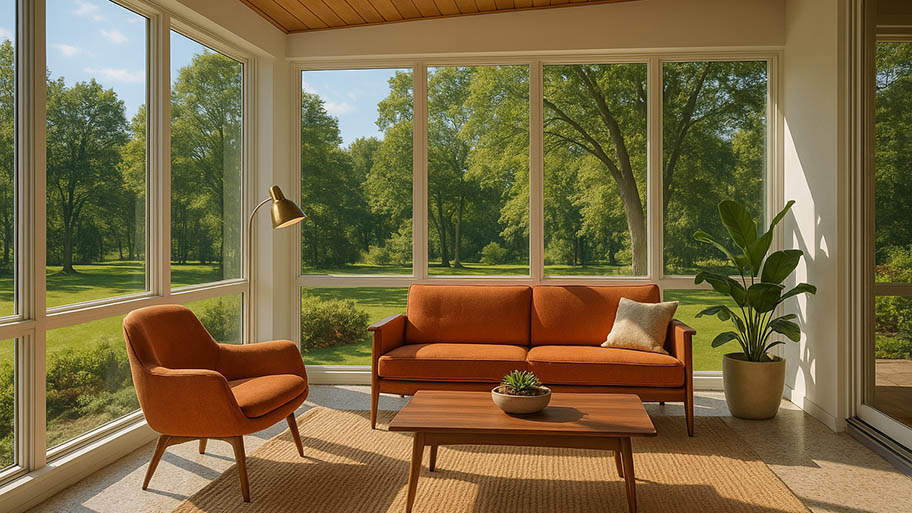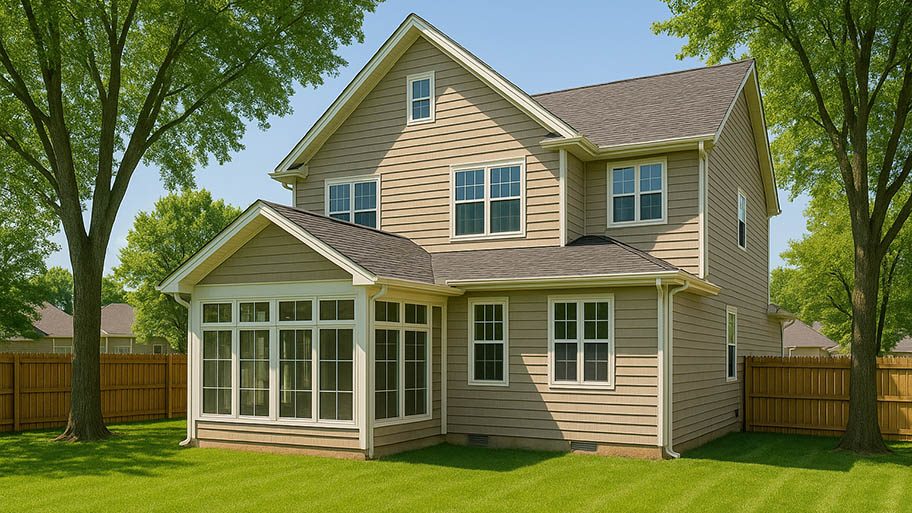
When you're ready to kick back and enjoy nature without the bugs, a sunroom is your best option. Learn how much a sunroom addition costs to set your budget.
Enjoy a cozy and protected screened porch all year round


A screened porch is a wonderful addition to your home, allowing you an extended living space to enjoy the outdoors comfortably. But when winter comes, it's time to winterize your screened porch to ensure it remains beautiful and functional for years to come. Check out our eight tips to winterize a screened in porch, so you can make this space cozy during the cold months.
One of the most effective ways to winterize a screened porch is by turning it into a sunroom or enclosed porch. This method will likely require renovations and may involve replacing the screens with glass or other insulating materials. Compared to other methods, a four season room offers a higher level of protection against cold. By enclosing the porch, though, you create a fully insulated space to use year-round.
An alternative to creating a four season room is to install vinyl panels to winterize your screened porch. These panels can be attached to the existing screen frames, providing an additional layer of insulation and protection from the elements.
The great thing about vinyl panels is that they are clear, allowing natural light through while keeping the cold air out. They are also relatively easy to install and remove, allowing you to easily winterize your screened porch.
Vinyl sheeting is an even more cost-effective way to winterize your screened porch. This method involves attaching large sheets of vinyl to the interior or exterior of the screens. The sheets act as a barrier against wind, rain, and cold air, providing insulation and reducing heat loss.
While vinyl sheeting may obstruct the view to some extent, it effectively keeps the porch warmer during winter months.
Vinyl curtains are a versatile option for winterizing a screened porch. These curtains can be hung from the ceiling or attached to the existing screen frames, depending on the type of screens on your porch, allowing you to enclose the porch as needed. They provide adequate insulation and protect against some cold drafts while still allowing for airflow when desired.
Vinyl curtains are also easy to open and close, providing flexibility in controlling the porch's exposure to the elements.
Before winter arrives, it's important to remove any furniture and decorations that are vulnerable to cold and moisture damage. Wood furniture, ceramic or glass items, as well as absorbent rugs and cushions, are particularly susceptible. Replace them with winter-appropriate items made from materials like aluminum, recycled plastic, concrete, teak, or other weather-resistant materials.
To ensure your winterized porch remains well-sealed, take the following steps to weatherproof it:
Recaulk doors and trim to prevent drafts
Check for cracks or gaps in the structure and repair them
Waterproof electrical outlets and lighting fixtures
Seal the floors and walls with a waterproof sealant to protect against moisture
Before winter sets in, thoroughly clean your screened porch. This helps prevent mold growth during the wet and cold months. Remove any debris, dirt, or leaves that may have accumulated. Clean the screens, floors, and furniture, and consider using a mold-inhibiting cleaner to further protect against mold and mildew.
Make your winterized porch a cozy and inviting space by adding winter-friendly elements. Consider incorporating weatherproof cushions, a gas fire table or patio heater for warmth, cozy blankets, and other accessories that enhance comfort. These additions will allow you to enjoy your porch throughout the year, even when the temperatures drop.

Winterizing your screened-in porch is an investment, but it allows you to maximize its use and protect its longevity. Learn about some of the benefits of winterizing a screened-in porch below.
Winterizing your screened porch can significantly extend its life span. By protecting it from harsh winter elements such as snow, ice, and freezing temperatures, you can prevent damage to the structure and materials, including the screens themselves. Proper winterization measures will help preserve the integrity of your porch and ensure it remains usable for many years.
Winter weather can be harsh on your porch furniture and decor. By winterizing your screened porch, you can safeguard your furniture from moisture, mold, and cold temperatures. It's important to remove any items that are susceptible to damage, such as wood furniture, ceramic or glass decorations, and absorbent rugs or cushions. Replace them with winter-appropriate materials like aluminum, recycled plastic, concrete, or teak that can withstand the winter conditions.
Winterizing your screened porch allows you to utilize it as an extended living space, even during colder months. By implementing the right winterization techniques, you can create a cozy and comfortable space that provides shelter from the elements. With the right screened-in porch ideas, you can enjoy outdoor views, entertain guests, or simply relax in a protected environment, regardless of the weather outside.
When it comes to winterizing your screened porch, you can choose to tackle the project yourself or hire a professional. DIY methods are often more budget-friendly, but they require time, effort, and some level of skill. Hiring a professional ensures a high-quality and efficient winterization process, especially if you're considering major renovations like creating a four season room.
Consider your budget, time availability, and the complexity of the project when deciding whether to DIY or hire a local porch builder.
From average costs to expert advice, get all the answers you need to get your job done.

When you're ready to kick back and enjoy nature without the bugs, a sunroom is your best option. Learn how much a sunroom addition costs to set your budget.

Use our expert guide to figure out how much it costs to install a pool enclosure. Establish your budget, then plan your pool enclosure project.

Considering adding a screened porch to your home? Discover the average cost of a screened-in porch, depending on its size, location, and more.

Not sure if you’d prefer a sunroom vs. a screened porch? Use this comprehensive guide to help you decide which you’d get more value from in the long run.

From inflatable domes to self-built structures, DIY pool enclosures are a doable home project. Here's how to approach the project like a pro.

Are mosquitoes and bugs ruining your outdoor experience? Learn how to build a screened-in porch from start to finish for pure backyard enjoyment.